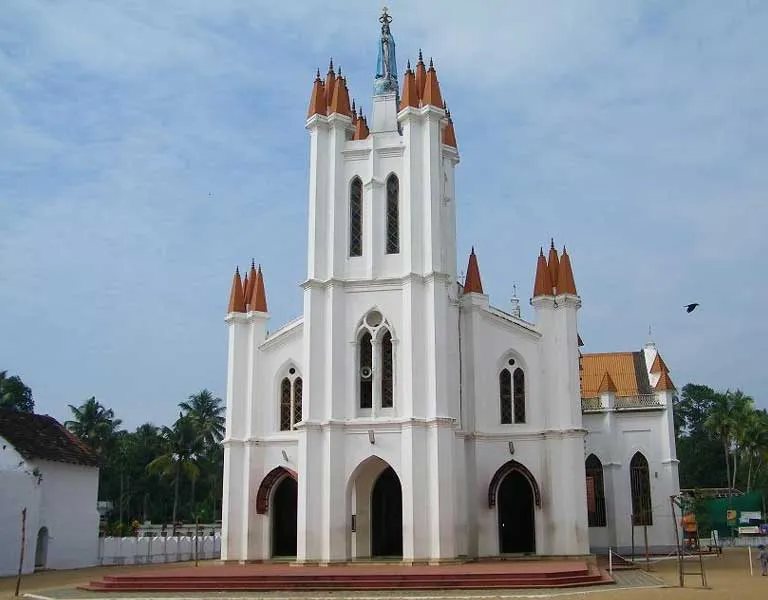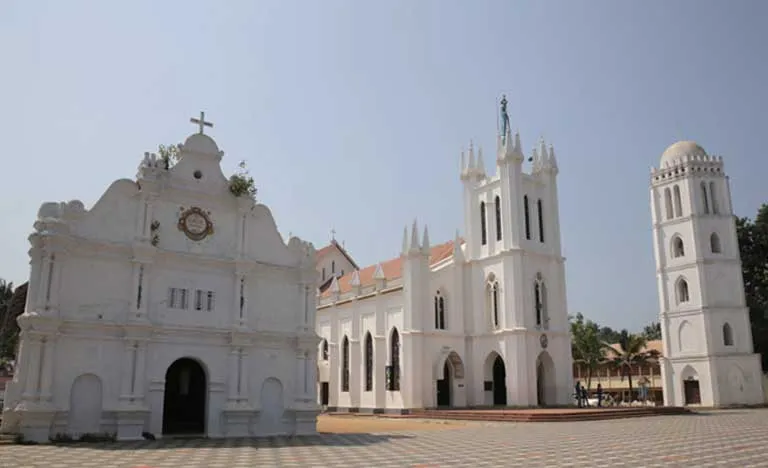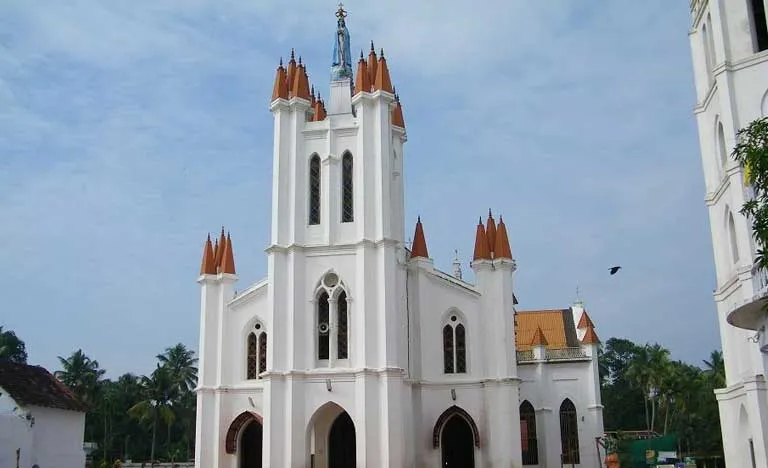
Introduction
The Basilica Of Our Lady Of Snows, Pallippuram, Kochi, Kerala, India (Diocese of Kottappuram) Preface Basilica of Our Lady of Snow at Palliport is One of the most famous Marian Pilgrimage Centre in Kerala, which is frequented by quite a large number of devotees belonging to different religions and castes .The fort situated on its northern side, the Little Flower Convent on the southern side, the Kadalattu kurish Chapel on the western side, are also famous centres of historic, religious and cultural importance.
The Basilica of Our Lady of Snows, Pallippuram – Nossa Senhora das Neves originally built by the Portuguese in the year 1507 AD was elevated to a Basilica in 27th August 2012 by Pope Benedict XVI. Papal Nuncio to India, HE Archbishop Salvatore Pennacchio declared this Papal decree at the grand celebration of the silver jubilee of Kottapuram Diocese in the Ecclesiastical province of Verapoly, Kerala. What was started as a small chapel by the Portuguese after they built the Pallipuram Fort in the year 1503 AD, to venerate our Lady was rebuilt with Gothic arches in the year 1931. It saw major renovation in 2006 before it celebrated its 500 year of existence, the next year – 2007.
At Pallippuram near Cherai in Kerala, is the Manjumatha Church, one of the oldest basilicas in the state and a popular one. The church is not only famed for its age but also because it is only one of the three pilgrim centres in South India dedicated to Our Lady, Virgin Mary. The Manjumatha Basilica has its own historical significance as it is associated with Tipu Sultan’s invasion of south India in the 18th century. During that time people shut themselves inside the church and prayed to their holy mother. It is said that heavy fog shrouded the church which in turn misled Tipu Sultan’s army who turned back. The church obtained its name after this incident. ‘Manjumatha church’ means “the mother’s church shrouded in snow.”
This famous church is dedicated to Our Lady. It is not only one of the oldest churches in the Diocese of Kottapuram, but also one of the three pilgrim centres in South India which was dedicated to Our Lady in the 16th century (before 1550). The others are Vailankanni and Vallarpadam.
It is about 34 km from the Basilica of Our Lady of Ransom, Vallarpadam. The Church is just 3 km from one of the most beautiful beaches in the West Coast of India – Cherai Beach. This basilica is next to (about 500 meters) the oldest European Fort in India – Pallipuram Fort. Cochin/Ernakulam region has probably the highest numbers of Basilicas in India – 5 – St. Mary’s Cathedral Basilica, Santa Cruz Basilica, Vallarpadam Basilica of Our Lady of Ransom, Basilica of St. George and Basilica of Our Lady of Snows. Kerala also has the maximum number of Basilicas in India – 8 in all out of the total of 21.
During the Mysorean invasion of Kerala in the 18th century, Tipu Sultan was camped near the River Chalakkudy in order to attack parts of Travancore. He destroyed most of the Christian and Hindu places of worship. The local people gathered together in the church and prayed to Our Lady for her help. At that time, there was a mist (snow) spread around the church and Tipu and his military could not see the church or the surrounding areas. They thought it was part of the Arabian Sea. There was also a high flood in the River Periyar and Tipu lost a huge part of his military and returned to Mysore. It was the miracle that changed the name of Our Lady to Manjumatha (Our Lady of Snow).
In 2007, the Church celebrated its 500th anniversary.
The church was renovated in 1931 and 2006.
500-year-old Portuguese painting that adorns the altar of the Basilica of Our Lady of Snows, Pallippuram
History Of Our Lady of Snows, Pallippuram


The name – Our Lady of Snows (Manju Matha in Malayalam literally means Mother of Snows or Mist) to this church is because of what happened on one day in 1789 AD during Tippu Sultan’s intended invasion of Travancore state through the river Chalakudy. Tippu Sultan was exceptionally harsh on Hindus and Christians. He forcibly converted Hindus and people of other faith to Islam and razed many temples and churches. So on that day when his Army was searching for the Christians near Vypin, they took shelter in this Pallipuram church and prayed for the intervention of our Lady.
Miraculously a thick mist descended on parts of the island forcing the invading Moslem Army to think that the region was part of the Arabian sea. In addition, Tippu lost a lot of his men in the flash flood in the river Periyar forcing him to retreat. From that day the grateful people of this region called Our Lady as ‘ManjuMatha’.
The Basilica of Our Lady of Snows, Pallippuram, Ernakulam, Kerala, is a minor basilica. The basilica decree was issued on 27 August 2012. The raising of the Pallippuram church was officially announced at the conclusion of the silver jubilee celebrations of the diocese on 7 October. The history of the Our Lady of Snow Church goes back five centuries when the Portuguese built a fort at Pallippuram and immediately followed it up with a church dedicated to Our Lady.
This famous Manjumatha Basilica is dedicated to Our Lady. It is not only one of the oldest churches in the Diocese of Kottapuram, but also one of the three pilgrim centres in South India which was dedicated to Our Lady in the 16th century (before 1550).
In 52 AD, St. Thomas, the apostle landed in India at Maliankara near the port of Musiris. This Port was also called Muchiri because the Periyar branches out into three (In Malayalam these three branches were called Muchiri or three broken lips) before it joins the Arabian Sea.
This was one of the oldest and busiest port on the West Coast of India known to the world by more than twenty different names. In the biggest ever flood known in the history of Kerala, this Port was washed off in 1341 AD and a new Island known as Vypin was formed near Kochi or Cochin in the Vembanad Lake.
People from various places migrated to the new island. Portuguese built a fort at Pallippuram as a watchtower. It was in 1503. It is the oldest existing European fort in India. Same time, the Portugese built a Church for the believers surrounding area and dedicated to Our Lady. It was the church on that time, where Christians in that area gathered together for worship.
During the invasion of Mysorean in Kerala in 18th century, Tipu Sultan was camped near River Chalakkudy for attacking parts of Travancore. He destroyed most Christian and Hindu worship places. The local people gathered together in the Church and prayed to Our Lady for their help.
At that time, there was a mist (snow) spread around the church and Tipu and his military they could not seen the church or surrounding areas. They thought it was part of the Arabain Sea.
And there was also a high flood in River Periyar and Tipu lost a huge part of his military and returned to Mysore. It was the miracle turned Our Lady’s name to Manjumatha (Our Layd of Snow).
The Basilica of Our Lady of Snows, Pallippuram, Ernakulam, Kerala, is a minor basilica. The basilica decree was issued on 27 August 2012. The raising of the Pallippuram church was officially announced at the conclusion of the silver jubilee celebrations of the diocese on 7 October.
The history of the The Basilica of Our Lady of Snows, Pallippuram goes back five centuries when the Portuguese built a fort at Pallippuram and immediately followed it up with a church dedicated to Our Lady. The church was established in 1503, renovated in 1931 and rebuilt in 2006. The church came under the diocese of Kochi in 1557 and became a parish in 1577. The Kottapuram diocese was formed by dividing the Varappuzha diocese.
Tradition


One of the Traditions is – when Tipu Sultan came from Mysore with his armors, destroying the churches and all things made by the Portuguese, reached near Pallippuram, banks of the River Chalakkudy. Then the nearby people gathered in the Church and prayed to Mother Mary. And then the place was covered with snow – even the season was Summer! There after this church is known as in the name of “The Basilica of Our Lady of Snows, Pallippuram” or “Manjumatha” in Malayalam.
Feast Day – 5th August
The annual feast of The Basilica of Our Lady of Snows, Pallippuram is celebrated on 5 August every year. This annual feast is symbolic of the dedication of the Church of Santa Maria Maggiore on the Esquiline Hill in Rome – the original Church of Our Lady of Snow. The 15 day feast starting from 30th July ends on the Day of Assumption of Our Lady – 15th August.
Mass Time
Weekdays
Saturdays
Sundays
Church Visiting Time
Other Facilities
Art Gallery
Palakkal Art Gallery – Art of Interior Design ” beauty in excellence ” Art Gallery
Contact Info
Basilica of Our Lady of Snow (Manjumatha Basilica),
Pallipuram Church Road, Vypin, Pallipuram, Kochi,
Ernakulam District, Kerala – 683 515, India
Phone No.
Tel : 0484 – 248 8053
Accommodations
Connectivity
Basilica of Our Lady of Snows, Pallippuram, Kochi, Kerala, India is well connected with Bus Station, Railway Station and Airport facilities rest of the country.
Airways
Cochin International Airport, Kerala Which is (27.3 Kms) from Basilica of Our Lady of Snows, Pallippuram.
Railways
The nearest railway station is Aluva Railway Station which is (24.4 Kms) from Our Lady of Snows, Pallippuram.
Roadways
The nearest is North Paravoor KSRTC Bus Station which is (8.5 Kms) from Our Lady of Snows, Pallippuram.









